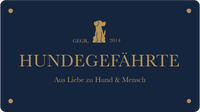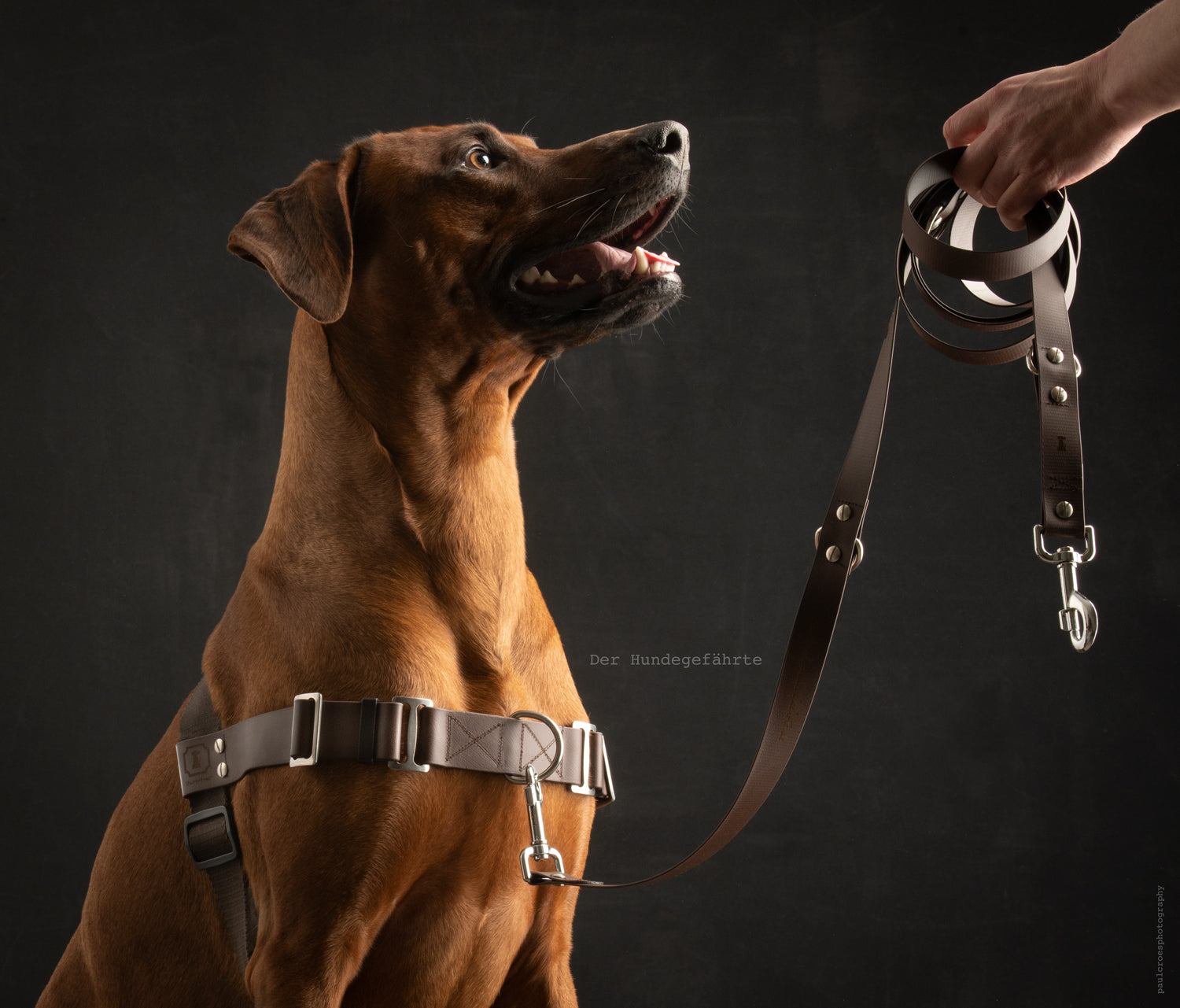Training with STURMFREI®
Training with STURMFREI® is easy. Because it's easy for the dog to understand and he doesn't get irritated. He neither feels threatened like he does with a collar, nor is he driven to chase like he does with a chest harness.
If you want a relaxed dog, then use STURMFREI® and save yourself years of duels on the leash.
In the following video you can see four dog examples and their reactions. You can see the before and after videos with the dogs under “ Before and After Videos ”.
Dogs:
1. STURMFREI® training with a young boxer dog
- generally well utilized (free running, interaction with other dogs, no biting experience)
- Owner very committed to dealing with dog, owner rejected violence during training
- Increased risk of developing leash aggression (breed and collar)
Problem:
- The dog walked well on the leash until she became very aware of something. With a retriever leash, she stiffened her neck, stood still (petrified) or pulled with any force in the direction of the stimulus.
Solution: STURMFREI®. Even if the dog's attention was focused on something, she could easily be turned away. Without the pull on her neck, she didn't turn to stone and turned to the owner when the leash was tightened.
2. STURMFREI® training with an adult Labrador:
- basically socially competent
- Coarse body movements (too little limitation from other dogs when they are young dogs)
- a bit clumsy and overwhelmed by his urge to explore whenever something interested him
Problem:
- The dog couldn't be held, he jumped left and right when he was on his collar, barked and constantly changed directions and pace. He was put in the hunt on the chest harness and was caught in a continuous pulling mode
Solution: STURMFREI®. The dog was initially “calmed down” over several walks. By removing the collar, he walked more calmly and stopped barking, he looked at the owner more often and his tension disappeared. Leash walking training was then possible.
3. STURMFREI® Training with Malinois
- basically socially competent (despite belonging to a Schutzhund breed!)
- The owner allowed the dog to perform breed-specific tasks (learning tricks, playing around with large dogs)
- Halterin was very fond of training and rejected the use of violence
Problem:
- Excessive irritation of the dog by the collar, increased aggression when the collar compressed the soft tissues of the neck
- Dog has an increased breathing cycle and scans for danger outside
- Increased risk of developing leash aggression
Solution: STURMFREI®. When switching from the collar to the STURMFREI® , the Malinois immediately stops its increased tension when the leash is tightened. Since the dog was already very attentive to his owner, she could easily call him to her on the STURMFREI®. With protection dogs, the owner's joyful attention is often praise enough for them to follow her and her commands (this is different, for example, with more independent breeds such as many hunting dog breeds). The owner had owned the STURMFREI® for 7 months at the time of filming. As soon as she switched to the collar, the dog switched back to the collar-related pulling behavior.
4. STURMFREI® training with protection dog/herding dog mix
- Dog very stressed and unsettled
- Encounters on leash were met with strong aggression
- Continuous muscle tension, constant feeling of being threatened, increased breathing frequency (heavy panting)
- The owner tried to use a collar to get the dog out of stressful situations, but the dog then escalated even more
Solution: STURMFREI® . Initially, the training was about removing the pull on the neck as an additional element of threat. The tightening of the throat made the dog become more and more nervous and anxious . In addition, the dog's field of vision was influenced: it was turned away when it saw something that made it particularly aggressive/fearful. Eye contact with the owner was provoked and treats were used. The purpose was to initially interrupt the stimulus-response chain that the dog had learned. By changing from stress (sighting the other dog) to “my home” (looking at the owner), the agitation was prevented from continually increasing and the dog did not remain in a threatened state for several minutes. In such cases, training takes longer because the dog has to be brought out of the learned reactions (which occur automatically in the organism through many repetitions). This happens by eliminating stressors (collar, chest harness) and by visual interruption.
FAQs
No, he doesn't have to. However, it has two advantages:
1. As with us humans, the reaction to “slow down” is most instinctive when pressure is applied to the shoulder from the front. (To do this, spontaneously press against your shoulder and you will feel it go backwards instead of in the opposite direction).
2. The shoulder is not a “threatening” place for the dog. This means: If he feels pressure on his shoulder, it doesn't trigger a feeling of strong threat (as is the case with the collar). This means: It is less stressful for the dog to be slowed down at the shoulder than in the area above and he is more likely to react to braking at the shoulder by stopping (instead of fleeing, aggression/resistance).
Yes, pull longer lines through the carabiner at the back and attach the line carabiner at the front. However, it is advisable to use a shorter leash for the first few walks, as the tension on the leash will direct the angle upwards and not to the left (if you are walking on the left).
It is good for the dog's learning effect that he is initially braked horizontally from right to left so that he realizes this and does not have to exert strong pressure.
Yes, the earlier a dog gets to know how to lead as naturally as possible, the fewer problems arise later. By turning towards you, the dog also learns to orientate itself more towards you later when free running (frequent eye contact). But please also consider: Dogs, like children, learn through experiences with the environment. They want to interact, sniff, walk, and learn to assess themselves and others. It is therefore very important to give the dog these experiences.
With the STURMFREI®, contact with other dogs on a leash is also possible by not tightening the neck (collar) or throwing it back (chest harness). This will help you avoid leash aggression in the long term.
If your dog constantly has his nose on the ground and is flat on his sides, check the belly strap. When he bends forward, the belly strap will slide forward if it is not adjusted tightly enough.
If you want to attach the dog to something where he has to wait, or if you want to quickly get to the car, you can also attach the leash directly to the stainless steel slider at the back. This is a little bigger than the slider on the front strap, as the snap hook for pulling the leash through is hooked into one side. Use the free side for briefly attaching the dog.
However, if you lead the dog over a longer distance using the stainless steel handle at the back, you will be confronted with the same problem as with chest harnesses: Leading from behind provokes the dog to pull forward/focus on the stimulus in the front visual/smell area.
Yes. If you want your dog NOT to pull. When riding a bike, generally make sure that your dog has enough leash (doesn't run too close to the spokes and could fall behind). Please also note: Other dogs can react aggressively to a dog sprinting past them, as in nature they do not tolerate - from their point of view - being "ambushed" out of nowhere (especially if they have nervous people with them) .
Therefore, with your dog on a leash, only drive on routes where it is compulsory to be on a leash or slow down and give the dog a large leash radius so that he and the other dogs can determine through interaction with each other that there is no danger.
All texts and content are written by Nina Bednarz (Communication Sciences, Sociology MA) and arise from her accumulated specialist knowledge.
The content is based on specialist knowledge of mammalian learning behavior, interaction and communication rituals, which follow similar structures across species.
There is currently no book in the dog area that deals with these connections.
Any reproduction of the content must be marked with regard to copyright. Failure to provide a source will result in legal action.
Sources should be marked as follows:
Nina Bednarz (Communication Science, Sociology MA), The Dog Companion, www.der-hundegefaehrunge.de
Online seminars are being planned for 2023.
STURMFREI® has been patented since 2014 and is protected in Germany, England, Ireland, France, Spain, Italy, Austria, Poland and Switzerland. The STURMFREI® brand is also under protection.
STURMFREI® was constructed and is explained by Nina Bednarz (Communication Sciences, Sociology MA)
STURMFREI® is protected by the EU trademark EUTM 013790241 registered with the European Union Intellectual Property Office (EUIPO) and by the European patent EP 3 209 120.
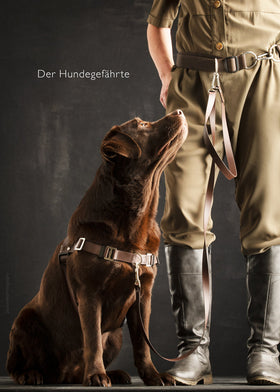
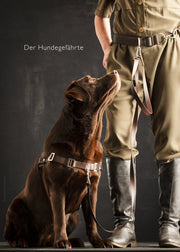
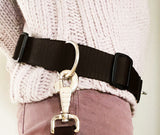
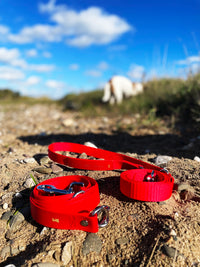
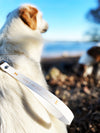
Relief
Belly belt CHILL
Guide your dog using a holder on the waist belt. Your dog orientates itself through the tension of the body and is therefore less exposed to irritation caused by changing the tension of the leash due to the arm swinging around.
